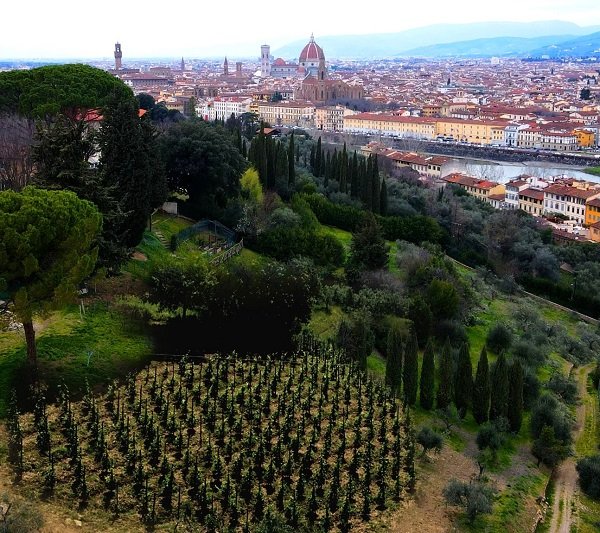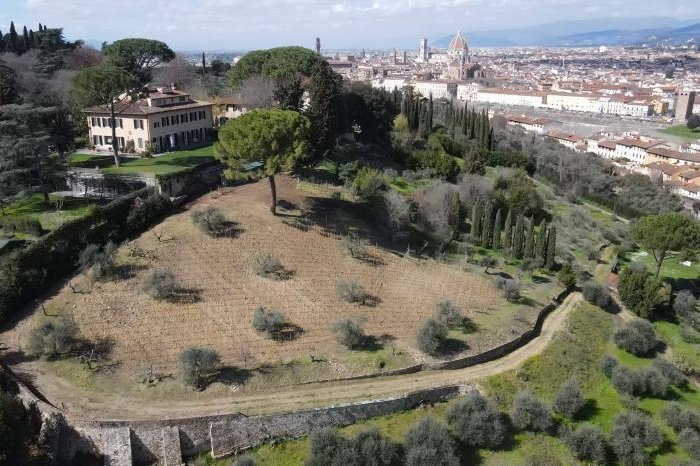The first modern urban vineyard in Florence is pink. Young female entrepreneurs plant 700 new vines creating Vigna Michelangelo.
We are on the hill overlooking the Arno River, just a few steps from Piazzale Michelangelo, with a view that sweeps from Brunelleschi’s dome to the hills of Fiesole, and next to the Iris Garden where the germplasm of the Iris genus, the symbol of Florence, is preserved. Here is a large plot with vines and olive trees managed by the farm Donne Fittipaldi of Bolgheri, chaired by Maria Fittipaldi Menarini. An all-pink company: Maria runs it with her four daughters Carlotta, Giulia, Serena and Valentina, and together they have thrown themselves with conviction and enthusiasm into a project that is simultaneously ancient and innovative.
A project born from Bolgheri’s winemaking experiences, but also from Maria Menarini’s childhood memories: “when in early September, returning from vacation, I loved to pick grapes and even some bunches for the table” in the rows cultivated in the park of the Florentine house by her father Mario.

The project of the “Michelangelo Urban Vineyard” had started on September 29, 2021 with the expectation of the complete conversion of the plant into a garden vineyard perfectly integrated with the environment surrounding, while maintaining the characteristics of the landscape. The technical direction of the work was entrusted to the same team that looks after the Bolgheri vineyards: agronomist Stefano Bartolomei and winemaker Emiliano Falsini.
The technical aspects of the Michelangelo Vineyard
Once all legal permits and approvals were obtained, on March 14, 2024, the rooted cuttings were buried in the holes. The area designated for the vineyard had been prepared in the previous months, with a cleanup of extraneous plants and larger stones. Wooden brace stakes were then planted at the approximately 40-cm excavation needed to accommodate the rooted cuttings.
A sapling, the oldest known form of breeding, practiced by the Greeks and Romans, but also the most qualitative and expensive: it allows the arboreal development of the plant to be very well controlled and kept limited in favor of better cluster growth. The so-called “quincunx“. Each sapling sits on the vertices of a square that has another vine in the center, like the face of a die with the number 5 on it. The visual aspect is scenically spectacular while soil occupancy is optimized and the vine can develop its roots in the best possible way even on steep terrain such as that of Vigna Michelangelo.

So on March 14, forty journalists, experts and communicators were invited to plant a vine stump personalized with their names. When the vineyard goes into production each will receive a personalized bottle that will remind them of the vine planted.
The numbers of the Michelangelo Vineyard

For the Michelangelo Vineyard, 700 vines of different varieties, all native to Tuscany, were used:
300 vines are of Sangiovese, Tuscany’s princely grape variety, with clones chosen in the CCL2000 selection.
150 vines are of Canaiolo, also a widely planted vine in all Chianti areas to impart elegance and lightness to the wine.
100 vines are from Foglia Tonda, a grape variety grown successfully in the Val d’Orcia and the Arno Valley, which combined with Sangiovese gives greater robustness to the wine and greater longevity.
Another 100 vines are of Pugnitello, a variety that is offering interesting results in Tuscany, and which owes its name to the characteristic shape of the cluster with a small closed fist.
Finally, 50 vines are of Colorino del Val d’Arno, also known as Abrostino or Abrusco. The name is due to its skin, which is intensely endowed with a dark red color. In autumn, the leaves turn a fiery red and provide a unique scenic effect.

What future for the Michelangelo Vineyard?
The rooted cuttings will bear their first fruit suitable for winemaking only in three years, only to reach the pinnacle of quality much later. Wine requires patience, but in the meantime, the date is for the 2027 vintage with the production of the first cask of wine with entirely Michelangelesque vigor. “About 700 bottles will be made from that cask –concludes winemaker Falsini– to be sold on the international market through auctions with charitable purposes of social support. The purpose of the vineyard for Maria Fittipaldi is not only wine, but the relationship that is created between man, earth and air, a relationship that resizes the sterility of concrete and asphalt with the search for mutual respect“.
Urban vineyards, the state of the art in 2024
Strolling through the center of Florence, you can follow an itinerary completely dedicated to the vineyard. Starting from Santa Croce, one reaches the Palazzo Vecchio by going through Via Vinegia and then Via della Vigna Vecchia, from here we continue towards Palazzo Strozzi to turn onto Via della Vigna Nuova which leads to the Lungarno Vespucci.

Already the Romans, at the suggestion of Cato the Censor, purchased vineyard land in the cities they founded or conquered. Then from the Middle Ages it was the monks, Benedictines, Dominicans, Vallombrosans, who tended the vineyards to produce wine for the Holy Mass, saving them from barbarian invasions from the north and Moorish invasions from the south. Then urbanization and industrial culture have peremptorily removed the vineyard from the urban fabric, but recently the awakening of environmental culture and the quest for sustainability have created the need for the return of greenery within large cities.
Urban vineyards in the world and in Italy
All over the world, urban vineyards have found new life. The oldest and most prestigious is definitely the Clos Montmartre, immortalized by artists such as Aristide Bruant and Toulouse Lautrec, while the most unconventional is the Rooftop Reds or 42 planters on 1,400 square meters of rooftop on the high-rise in the Brooklyn Navy Yard that produce about 300 bottles a year, all of which are contended by enthusiasts despite less than popular prices.
Famous in Italy are the Queen’s Vineyard in Turin, overlooking the Mole and the Gran Madre, Leonardo’s Vineyard in Milan, now acquired by luxury magnate Bernard Arnoux of the LVMH Group, Clos Venissa in Venice in Mazzorbo di Bisol, the vineyard of the friars of St. Francis of the St. Margaret’s Group, to Siena the Senarum Vinea.
Moving down south we find in Sicily the Etna Urban Winery, in Pompeii the vineyards of the Villa dei Misteri of Mastroberardino, a Naples the San Martino vineyard. Of particular note is the King’s Vineyard in the Royal Palace of Caserta: is cared for by the same agronomist at the Vigna Michelangelo in Florence, Stefano Bartolomei, who planted Pallagrello Nero and Pallagrello Bianco on the Tenuta delle Reali Delizie, as Ferdinand of Bourbon called it. A Rome there are plans for a vineyard in Trinità dei Monti and one, the Vigna Bellone, in the park of the Colosseum. And now toVigna Michelangelo: an urban vineyard is reborn in the heart of Florence

An association, the Urban Vineyard Association, with the prospect of developing a system of ecological production, sustainable tourism and hospitality, and the redevelopment of inaccessible or even degraded contexts that can act as a link between private producers and institutions.





